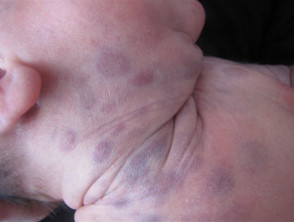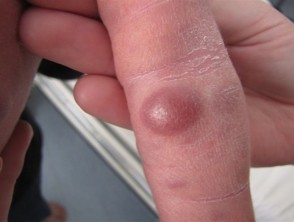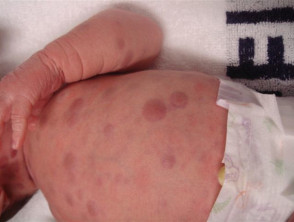What is blueberry muffin syndrome?
‘Blueberry muffin syndrome’ is the descriptive term used for an infant born with multiple blue/purple marks or nodules in the skin. These are due to the presence of clusters of blood-producing cells in the skin (extramedullary erythropoiesis), or bleeding into the skin (purpura), or spreading cancer (metastases).
Blueberry muffin syndrome
What are the causes of blueberry muffin syndrome?
There are many underlying causes that need to be considered when a baby presents with blueberry muffin syndrome. These include:
Tumours such as:
- Congenital leukaemia cutis
- Langherhans cell histiocytosis
- Neuroblastoma
- Congenital rhabdomyosarcoma
Blood disorders such as:
- Haemolytic disease of the newborn – rhesus or ABO incompatibility
- Hereditary spherocytosis
- Twin-twin transfusion syndrome
Congenital infections such as:
- Rubella
- Toxoplasmosis
- Cytomegalovirus
- Herpes simplex
- Coxsackie virus
- Parvovirus
- Epstein-Barr virus
- Syphilis
The TORCH complex is a medical acronym used for these serious congenital infections: Toxoplasmosis, Other infections, Rubella, Cytomegalovirus, Herpes simplex virus. The other infections are hepatitis B, coxsackie virus, syphilis, varicella-zoster virus and parvovirus/erythrovirus B19.
Associated symptoms and signs
Frequently there may be associated anaemia and enlargement of the liver and spleen (hepatosplenomegaly).
Infants with congenital infection may show other features such as:
- Poor growth (intrauterine growth retardation)
- Jaundice
- Abnormal development of the central nervous system (which may include deafness, cerebral calcifications, impaired neurodevelopment, microcephaly/macrocephaly, chorioretinitis, seizures).
Management of blueberry muffin syndrome
The investigation and management of an infant with blueberry muffin syndrome often involves many specialists:
- Neonatologists
- Paediatricians
- Dermatologists
- Haematologists/Oncologists
- Infectious disease specialists.
Investigations may include:
- Full blood count and film – specialist review by a paediatric haematologist is recommended, as the initial features of leukaemia may be subtle.
- Skin biopsy – to look for features of leukaemia or tumours.
- Bone marrow biopsy – to look for features of leukaemia, blood abnormalities, infection or tumours.
- Ultrasound scan of the abdomen – to look for hepatosplenomegaly and neuroblastoma.
- Screening tests for congenital infection – TORCH screen, including maternal and infant serology and PCR, cerebrospinal fluid PCR, urine viral cultures, ultrasound and/or CT of the head, and other investigations as per clinical suspicion.
Treatment and prognosis
The treatment and prognosis depends upon the underlying cause.


